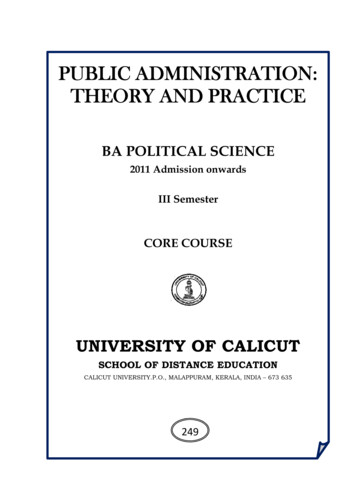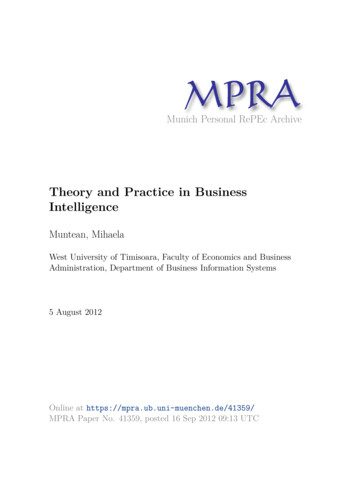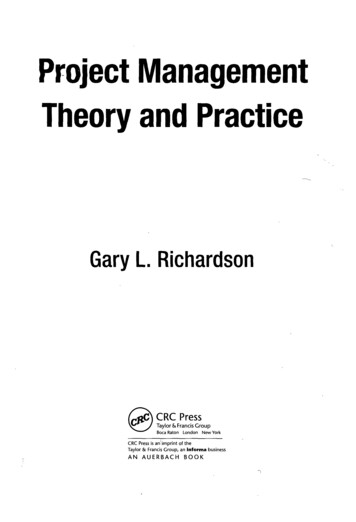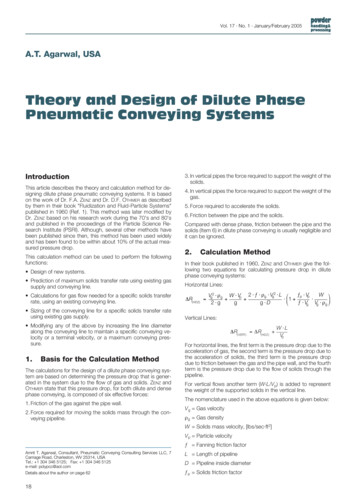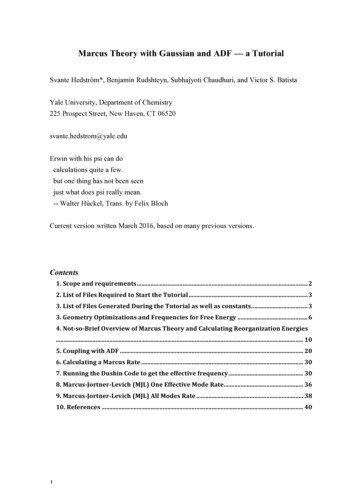
Transcription
Marcus Theory with Gaussian and ADF — a TutorialSvante Hedström*, Benjamin Rudshteyn, Subhajyoti Chaudhuri, and Victor S. BatistaYale University, Department of Chemistry225 Prospect Street, New Haven, CT 06520svante.hedstrom@yale.eduErwin with his psi can docalculations quite a few.but one thing has not been seenjust what does psi really mean.-- Walter Hückel, Trans. by Felix BlochCurrent version written March 2016, based on many previous OptimizationsandFrequenciesforFreeEnergy.64.Not- ‐so- ctivefrequency.308.Marcus- ‐Jortner- ‐Levich(MJL)OneEffectiveModeRate.369.Marcus- ‐Jortner- ‐Levich(MJL)AllModesRate.3810.References.401
1.ScopeandrequirementsThis tutorial will show you how to compute the classical Marcus Theory rate1-2 as wellas the more advanced Marcus-Jortner-Levich rate3 using ab initio DFT calculations for thebiphenyl (donor) - benzoquinonyl (acceptor) dyad, one of the dyads (#7) usedexperimentally to confirm the existence of the Marcus Inverted Region.4-5 First, we willuse the Gaussian software package6 to obtain free energies (ΔG) and reorganizationenergies (λ) (total, internal, and solvent) necessary to compute Marcus theory. Second, wewill use the ADF software package7-11 to compute the couplings between unoccupiedorbitals ( HAD ). Third, we will use the “Dushin” code to compute the “Huang-Rhys”factors.12 Fourth, we will use a home-made Fortran code that utilizes Monte Carlo tocompute an importance-sampled rate using the Marcus-Jortner-Levich expression. Thescience underlying Marcus Theory and Marcus-Jortner-Levich theory are explained morethoroughly in the publication from our group.13 The purpose of this tutorial is just to enableyou to do the relevant calculations described there.This tutorial assumes you are familiar with basic Unix commands such as grep as wellas using the Gaussian software package to run geometry optimizations and frequencies aswell as generate orbital isosurfaces (cubes) on a supercomputing cluster. The tutorial willbring you up to speed with using ADF and compiling a program with the Fortran compilerfrom Intel called ifort. Furthermore, it is assumed that GaussView is installed either locallyor on the supercomputer, and a Fortran compiler are installed on the supercomputer. TheFortran compiler ifort and GaussView exist as modules on Yale’s supercomputers Omegaand Grace. To use GaussView on the supercomputer, make sure to ssh with the -Y flag topermit graphical applications running over X-server. Additional instructions are ing for either PC or Mac.There are many files required to follow this tutorial, they can be found mastertutorial ask any Batista groupmember to add you to the Tutorials Dropbox folder if you don’t have access yet.2
PurposeBiPh-benzoquinonyl.xyzGeometry of the dyad.dushin-Svante.zipDushin code files.frag1.pbsSubmission script for ADF frag1 job (see Table X5).frag2.pbsSubmission script for ADF frag2 job (see Table X5).transferint.pbsSubmission script for ADF transferint job (see Table X5).writeAnADF version2.shScript that takes in the donor and acceptor fragment geometries to set upthe ADF input file fast.param.datParameters used for Monte Carlo codedushin.datSample input file used for Dushin sconstantsTable X1. Calculations needed for ΔG for either Marcus Theory or Marcus-Jortner-LevichTheory, from Gaussian.FilenameChargePurposeLevel of TheoryGeometry optimization of the log01dyad.BiPh-gs.log01Optimization/frequency on the donor cutb3lyp/6-31 (2d,p)to include only the extent of theLUMO 1 (isopropyl cy on the acceptorb3lyp/6-31 (2d,p)cut to include only the extent of theLUMO (isopropyl groups).BiPh-anion.log-1 2Optimization/frequency on the donor cutb3lyp/6-31 (2d,p)to include only the extent of theLUMO 1 (isopropyl groups).benzoquinonyl-anion.log-1 2Optimization/frequency on the acceptorb3lyp/6-31 (2d,p)cut to include only the extent of theLUMO (isopropyl groups).Table X2. Calculations needed for λT (total) for either Marcus Theory or forMarcus-Jortner-Levich Theory, based on geometries from Table X1, from Gaussian.Filename3ChargePurposeLevel of Theory
Multiplicitylambdatotal/anion-from-neutral/-1 alculationaniononb3lyp/6-31 logcalculationneutralonb3lyp/6-31 /-1 naniononb3lyp/6-31 logcalculationaniononb3lyp/6-31 (2d,p)neutralgeometry.Table X3. Calculations needed for λV (internal, which uses different SCRF keywords) forMarcus Theory, based on geometries from Table X1, from Gaussian.FilenameChargePurposeLevel of l/-1 alculationaniononb3lyp/6-31 on.logcalculationneutralonb3lyp/6-31 al/-1 naniononb3lyp/6-31 .logcalculationaniononb3lyp/6-31 (2d,p)neutralgeometry.Table X5. Calculations needed for the Boltzmann-averaged coupling ( HAD ).Filename4ChargePurposeLevel of
MultiplTheoryicityscan/B-Sp-benzoquinonyl scan 24 15.logscan/step#/frag10101Scan of the ground state in 24 stepsb3lyp/of 15 .6-31g(d)single-pointcalculationonthebiphenyl donor cut in the middle ofb3lyp/tzvpthe steroid spacer – needed at everyscan step zoquinonyl acceptor cut in theb3lyp/tzvpmiddle of the steroid spacer – neededat every scan stepscan/step#/transferint01frag1 and frag2 in the same file tob3lyp/evaluate the charge-transfer integralzvp– needed at every scan stepTable X6. Calculations, needed for the cavity volumes that go into distance correction to λas well as the input for the Dushin code, from Gaussian.FilenameChargePurposeLevel of TheoryOptimization/frequency on theb3lyp/6-31 (2d,p)MultiplicityforDushin/BiPh-gs.log01donor cut to exclude the Optimization/frequency on theb3lyp/6-31 (2d,p)acceptor cut to exclude the steroidcompletely.forDushin/BiPh-anion.log-1 2Optimization/frequency on theb3lyp/6-31 (2d,p)donor cut to exclude the g-1 2Optimization/frequency on theacceptor cut to exclude the steroidcompletely.Table X7. List of relevant constants.5b3lyp/6-31 (2d,p)
FilenameValueUnitTemperature (T)296.00KBoltzmann Constant (kB)8.61733E-05eV/K1 Hartree 27.2114eVPlanck’s Constant (ℏ h / quenciesforFreeEnergyThe file BiPh-benzoquinonyl.xyz contains the geometry of the full dyad withB3LYP/6-31G(d) (same as 6-31G*). It must be first relaxed to a minimum. Use this kindof input file (three dots indicate the rest of the coordinates):%nprocshared 12%mem 59GB%chk BiPh-benzoquinonyl.chk#p opt b3lyp/6-31g(d) scrf (smd,solvent thf)Optimization of the full dyad0 1C-4.026943001.595261000.51043100.The optimized structure is given in Figure 1. The SCF energy you get should be close to-1585.71942283 Hartrees.Figure 1. Optimized structure of the full dyad.The output optimized structure must then be cut into isolated fragments containing part ofthe steroid linker, as dictated by the extent of delocalization of the orbitals of interest that6
represent isolated electron density. For this particular case, it is the LUMO 1 of thebiphenyl group (donor) and the LUMO of the benzoquinonyl (acceptor), as illustrated byFigure 2. Note that the acceptor has the frontier orbital of lower energy.Figure 2. The frontier unoccupied orbitals (isovalue 0.02) of the dyad with the isopropylgroup to remain circled.Based on the isosurfaces shown in Figure 2, the molecule may be cut into two parts, adonor (biphenyl, left) and an acceptor (benzoquinonyl unit, right), as shown in Figure 3.However, the isodensity extends a bit onto the steroid linker, therefore the cut should bemade along bonds 1-2, 3-4, 9-11, and 8-10. After cutting, the valence of the danglingcarbon atoms should be filled by hydrogens, resulting in the structure shown in Figure 4.Figure 3. The structure of the whole dyad indicating where the molecule should be cut togenerate the fragments that can have isolated charge with particular carbon atoms labeledarbitrarily.7
Figure 4. The structure of the dyad fragments of the donor (biphenyl, left) and the acceptor(benzoquinonyl unit, right).These two dyad fragments, must now be optimized and their frequencies must becalculated, both with either a neutral/singlet and a anionic/doublet electronic state as givenbelow (remember to include at least 2 blank lines at the end of every input file):A. Donor, ground state of the neutral/singlet.%chk biph-gs neutral.chk%mem 59gb%nprocshared 12#p opt freq b3lyp/6-31 (2d,p) scrf (smd,solvent thf,Read) nosymm temperature 296donor ground state of the neutral/singlet0 2138000.28633000.NonEq writeB. Donor, ground state of the anion/doublet.%chk biph-gs anion.chk%mem 59gb8
%nprocshared 12#p opt freq b3lyp/6-31 (2d,p) scrf (smd,solvent thf,Read) nosymm temperature 296donor ground state of the anion/doublet-1 2138000.28633000.NonEq writeC. Acceptor, ground state of the neutral/singlet.%chk benzoquinonyl-gs neutral.chk%mem 59gb%nprocshared 12#p opt freq b3lyp/6-31 (2d,p) scrf (smd,solvent thf,Read) nosymm temperature 296acceptor ground state of the neutral/singlet0 469300-0.00025700.NonEq writeD. Acceptor, ground state of the anion/doublet.%chk benzoquinonyl-gs anion.chk%mem 59gb%nprocshared 12#p opt freq b3lyp/6-31 (2d,p) scrf (smd,solvent thf,Read) nosymm temperature 296acceptor ground state of the anion/doublet9
-1 469300-0.00025700.NonEq writeNote that these calculations are using a better basis set (6-31 (2d,p)) since the individualcalculations are now smaller. Also, note that the commandtemperature 296modifies theoutput of the frequency calculation to give free energies at 296 K, the temperature of theelectron transfer experiments (the temperature does not affect the optimization, since thepotential energy surface is not affected). Additionally, these calculations have thecommand scrf (smd,solvent thf,Read) to put in the dielectric continuum for THF as well asread in an additional command given after a blank line after the geometry specification.The additional command isNonEq writewhich saves the state of the continuum to thecheckpoint file for calculations of the total reorganization energy later in this tutorial.The free energies from these calculations should give results similar to these (in Hartrees):A. biph-gs neutral.log: Sum of electronic and thermal Free Energies B. biph-gs anion.log: Sum of electronic and thermal Free Energies -581.090755-581.144873C. benzoquinonyl-gs neutral.log: Sum of electronic and thermal Free Energies -499.329756D. benzoquinonyl-gs anion.log: Sum of electronic and thermal Free Energies -499.461972Therefore the free energy ends up being (with the B & C being the reactants and the A & Dbeing the products of the electron transfer):𝛥𝐺 𝐺 𝐷 𝐺 𝐴 – 𝐺 𝐵 𝐺 𝐶 27.2107𝑒𝑉 2.12540 𝑒𝑉𝐻Compare this value to the experimental value of -2.1 eV.54.Not- ‐so- nizationEnergiesAs alluded to in the previous section, the reaction of interest is (D Donor; A Acceptor):𝐷! 𝐴 𝐴! 𝐷The previous section calculated the ΔG:𝛥𝐺 𝐸! 𝐸!! – 𝐸!! 𝐸!10
On Figure 5, this value is𝛥𝐺 𝐸! 𝐸!Figure 5. Computation scheme for Marcus parameters.This free energy of electron transfer ΔG is used in the semiclassical, simplest form ofMarcus Theory:𝑘!",!"# %&2π 𝐻!" !(ΔG! λ)! exp 4λ𝑘! Tℏ 4𝜋λ𝑘! 𝑇where kB is the Boltzmann constant (Table X7), HAD is the electronic coupling betweendonor and acceptor and λ is the reorganization energy, which is related to the curvature ofthe parabola. There are two kinds of λ’s, one on the reactant potential energy surface (λ2)and one on the product potential energy surface (λ1). The two are to be averaged together:𝜆 𝜆! 𝜆!2The λ to be used here is actually called the total reorganization energy (λT) and includesthe contribution of the donor and the acceptor as well as the solvent.11
To calculate this λT, we must take the anion doublet donor and do a single point calculationchanging the charge & multiplicity to neutral singlet acceptor (to move that point from thereactant to the product parabola). Parallel calculations are done to change anion donor to neutral change neutral acceptor to anion change anion acceptor to neutralNonEq writeandNonEq readkeywords are used to fix the (implicit) solvation shell to theinitial state. This means that the reorganization energy has contributions from both thechange in geometry of the molecule and the solvent i.e. we get the total reorganizationenergy.Example input files are shown below to get points 3 and 4 in Figure 5. Note the useof %oldchk which will generate a copy of the .chk file. Put them in a different folder, calledlambdatotal.Point 3:%oldchk ./biph-gs anion.chk%chk biph-neutral-from-anion.chk%mem 59gb%nprocshared 12#p b3lyp/6-31 (2d,p) scrf (smd,solvent thf,ExternalIteration,Read) geom check nosymmdonor on neutral surface in the anionic geometry0 1NonEq readand%oldchk ./benzoquinonyl-gs neutral.chk%chk benzoquinonyl-anion-from-neutral.chk%mem 59gb%nprocshared 12#p b3lyp/6-31 (2d,p) scrf (smd,solvent thf,ExternalIteration,Read) geom check nosymmacceptor on anionic surface in the neutral geometry-1 2NonEq read12
Point 4:%oldchk ./biph-gs neutral.chk%chk biph-anion-from-neutral.chk%mem 59gb%nprocshared 12#p b3lyp/6-31 (2d,p) scrf (smd,solvent thf,ExternalIteration,Read) geom check nosymmdonor on anionic surface in the neutral geometry-1 2NonEq readand%oldchk ./benzoquinonyl-gs anion.chk%chk benzoquinonyl-neutral-from-anion.chk%mem 40gb%nprocshared 8#p b3lyp/6-31 (2d,p) scrf (smd,solvent thf,ExternalIteration,Read) geom check nosymmacceptor on neutral surface in the anionic geometry0 1NonEq readTable 1 gives the results you can expect to get. Please note that for reorganization energies,SCF energies, rather than free energies are used.Table 1. SCF Energies (for the total reorganization energy calculation) from the neutral or13
anionic part (the energy for the charge state that comes after “from” in the name is fromthe calculations in the previous section.Filenameanion SCFNumberneutral rom-anion.log-581.36293641-581.30068363Table 2. Total reorganization energies.VariableReorganizationComment/ eV totallambdaλ2λ11.6432Points 4-11.5186Points 3-2Average:1.5809In principle, the λT from Table 2 can be used in the Marcus Theory expression, but itmakes the approximation that the donor and acceptor are infinitely separated, which is nota good approximation necessarily if the parts are covalently linked as they are here.Therefore, the following equation is used as part of the routine to correct the energy, wherea is the solvent sphere shell radius (D donor, A acceptor) and R is the donor to acceptordistance:111 !"# %&λ!,!2𝑎! 2𝑎! 𝑅λ! λ!,! !"# %& λ!,!11λ!,!2𝑎! 2𝑎!λ!,! is the so-called solvent reorganization energy at the infinite distance approximation.λ! , the solvent reorganization energy without the infinite distance approximation is relatedto λ ! in the following way:λ! λ ! λ!where λ! is the so-called internal reorganization energy.To apply these equations, first the internal reorganization energy must be calculated.Conveniently, the input files are the same as for the total reorganization energy, except theadditional SCRF keywords must be modified as below. Put them in a different folder,called lambdainternal.Point 3:14
%oldchk ./biph-gs anion.chk%chk biph-neutral-from-anion.chk%mem 59gb%nprocshared 12#p b3lyp/6-31 (2d,p) scrf (smd,solvent thf) geom check nosymmdonor on neutral surface in the anionic geometry0 1and%oldchk ./benzoquinonyl-gs neutral.chk%chk benzoquinonyl-anion-from-neutral.chk%mem 59gb%nprocshared 12#p b3lyp/6-31 (2d,p) scrf (smd,solvent thf) geom check nosymmacceptor on anionic surface in the neutral geometry-1 2Point 4:%oldchk ./biph-gs neutral.chk%chk biph-anion-from-neutral.chk%mem 59gb%nprocshared 12#p b3lyp/6-31 (2d,p) scrf (smd,solvent thf) geom check nosymmdonor on anionic surface in the neutral geometry-1 2and%oldchk ./benzoquinonyl-gs anion.chk15
%chk benzoquinonyl-neutral-from-anion.chk%mem 59gb%nprocshared 12#p b3lyp/6-31 (2d,p) scrf (smd,solvent thf) geom check nosymmacceptor on neutral surface in the anionic geometry0 1Table 3. SCF Energies (for the internal reorganization energy calculation) from the neutralor anionic part (the energy for the charge state that comes after “from” in the name is fromthe calculations in the previous section.Filenameanion SCFNumberneutral rom-anion.log-581.36293641-581.30685693Table 4. Internal reorganization energies.VariableReorganizationComment/ eV totallambdaλ2λ10.5580Points 4-10.4736Points 3-2Average:0.5158Now we can calculate λ!,! , which isλ!,! λ !,! λ! 1.5809 𝑒𝑉 0.5158 𝑒𝑉 1.0651 𝑒𝑉Now to calculate the distance correction111 2𝑎! 2𝑎! 𝑅11 2𝑎! 2𝑎!we need to determine those a’s!16
Unfortunately, this requires yet another round of calculations on the same molecules, butwith so-called “truncated” spacers, as shown in Figure 6, completely mi
Yale University, Department of Chemistry 225 Prospect Street, New Haven, CT 06520 svante.hedstrom@yale.edu . scan/step#/transferint 0 1 frag1 and frag2 in the same file to evaluate the charge-transfer




